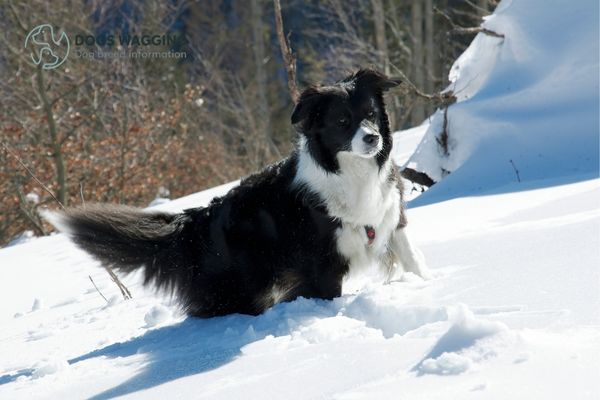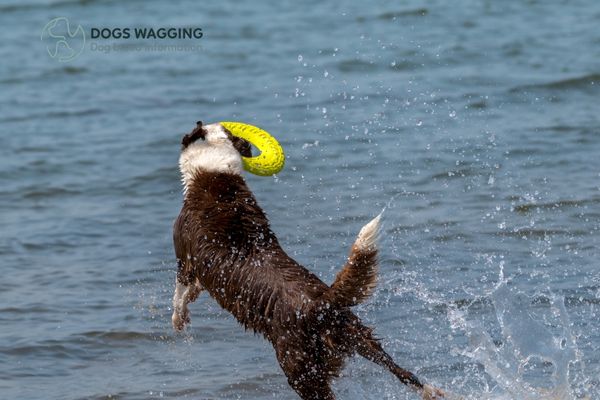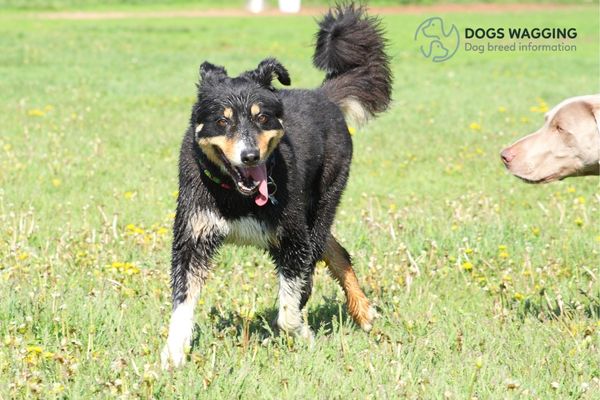John Switch • Tue Feb 27 2024
Border Collie Tail: All Fun Facts And Pictures

You may see some Border Collies and even have a Border Collie, but do you know what a Border Collie Tail looks like? Or how does a Border Collie communicate by their tail?
The tail of a Border Collie is of moderate length and set low on the body when the dog is engaged in work or focused on a task. It possesses a subtle upward curl at the tip and wags when the dog is experiencing happiness or excitement. It is important to note that the Border Collie's tail should never be curved over its back.
If you want to know more about Border Collie Tails, this article will give you all useful information: length, wagging and communication, common problems, grooming needs, and so on.
>> SEEMORE:
What Is a Border Collie?
The Border Collie is a farm herding dog that was originally developed to manage and guide sheep in the hilly region along the border of Scotland and England. It is purebred and renowned as one of the most high-energy, intelligent and likable dogs worldwide.
Border Collies typically have a medium-sized body with a beautiful double coat in various colors and patterns, such as black and white, red and white, or tri-color. Moreover, they have a strong desire to work and are exceptionally trainable, making them excellent companions for dog owners who enjoy engaging in agility, obedience, and herding trials.
About Border Collie Tail
Border Collies have a moderately long tail that is low on their body. Their tails extend from their backside and are hardly upward.
An entirely bred border collie typically has a white tip known as the shepherd's lantern. After a long day of herding, the shepherds use its white tip to guide them home, earning the nickname "shepherd's lantern".
The interesting fact about Border Collie Tail is that if their tail isn't white at the tips or curls slightly rather than straightens, it may be crossed with another breed. Therefore, it is normal to see that the Border Collie doesn't have a little hair on its tail; all that matters is which genes are more prevalent.
How Long Will Border Collie Tail Be?
The tails of Border Collies often measure from 12 to 16 inches in length. In some cases, border collies have tails that are anywhere from 3.5 to 16 inches long. If you look at the border collie's tail, which is shorter than the length standard, you will see that they may have had tail injuries or had their tail docked when they were born.
Does Border Collie Tail Curl?
In general, the tail of a Border Collie does not curl. The standard tail for a Border Collie is straight, extending to the back but not below it. While straight tails are the norm for this breed, there can be exceptions, particularly among short-haired Border Collies. Some short-haired Border Collies may have curled tails due to a recessive gene. However, it's important to note that tail curling in Border Collies is not a common trait and is unusual according to breed standards.
If you have a Border Collie with a curled tail, it's likely due to a genetic variation, but it does not affect the dog's overall health or intelligence. Many owners find this unique tail trait endearing and distinctive, and it's a reminder that individual dogs can have their unique characteristics.
Docking for Border Collie Tail
While tail docking is less prevalent in border collies than in other dog breeds, it still occurs. Tails of border collies may be docked to reduce the risk of occupational injuries. Notably, the official AKC breed standard for Border collies does not include tail amputation.
When Can Border Collies Tail Get Docked?
Tail docking in Border Collies is typically performed within the first 2 to 5 days after birth. It is the optimal time for the procedure. People believe that performing tail docking within this timeframe is less traumatic for the puppies, as their nerve endings, tissue, and blood vessels in the tail are not as developed as they would be if the procedure were done later.
It's important to note that tail docking is a practice that has generated ethical debates and concerns. Some argue that it can cause pain and distress to the puppies, and as a result, the procedure has been banned or restricted in many countries. It's essential to consult with a veterinarian and consider the legal and ethical aspects of tail docking before making a decision. In many places, it can only be performed by a licensed veterinarian and may be subject to regulations and restrictions.
How Long Is a Tail Docked?
When a Border collie has their tail docked, it is usually done to a length of three to five inches. Typically, the tail doesn't enlarge after this procedure.

Can Tail Docking Make Them Hurt?
Tail docking, when performed without anesthesia or proper pain management, can cause pain and discomfort to dogs. The procedure involves amputating a portion of a dog's tail, which contains nerve endings, blood vessels, and tissues. Cutting through these sensitive structures without relief can be painful for the dog.
Some people argue that puppies are less sensitive to pain at a very young age, but puppies can experience pain and distress during the tail docking procedure. Additionally, the pain experienced during tail docking can lead to short-term and long-term consequences, including:
- Immediate Pain: Dogs may exhibit signs of pain immediately after the procedure, such as whimpering, crying, or attempting to lick or chew the docked area.
- Short-Term Discomfort: Dogs may continue to experience discomfort or pain at the site of the tail docking for several days to weeks following the procedure.
- Behavioral Issues: The pain experienced during tail docking can lead to behavioral issues in dogs, including fear, anxiety, aggression, or others.
- Healing Complications: Without proper care and hygiene, the docked tail site can easily be infected, which can further create pain and discomfort.
Wagging and Communication of Border Collie Tail
Border Collies, like many other dog breeds, use their tails as a form of communication to express various emotions and signals. Here's how Border Collies communicate and wag their tails :
- Happiness and Excitement: When a Border Collie is happy or excited, it will wag its tail strongly. The tail may move in a wide motion, and the wagging speed can increase with excitement. These are clear signs of a cheerful and positive emotional state.
- Relaxation: In a relaxed and content state, a Border Collie's tail typically hangs down naturally. It doesn't curl upwards or to the side. A relaxed tail position indicates that the dog is comfortable.
- Alertness: When a Border Collie is alert or attentive, their tail is slightly upward from its relaxed position. An erect posture and perked-up ears often accompany this.
- Submission or Fear: If a Border Collie feels fearful, their tail may tuck between their hind legs or be low and close to the body. This is a submissive posture and can indicate that the dog is feeling anxious or unsure.
- Playfulness: During playtime, a Border Collie can wag its tail energetically. Playful tail wagging is usually accompanied by other playful behaviors, such as bounding, pouncing, and barking.
- Dominance or Aggression: A Border Collie displaying dominance or aggression may hold its tail high and rigid. This can be accompanied by other assertive body language, such as a stiff posture and direct eye contact.
- Curious or Investigative: When a Border Collie is curious or investigating something new, their tail may hold straight behind them.
It's essential to pay attention to a Border Collie's overall body language and context when interpreting tail signals. Tail position is just one aspect of their non-verbal communication.
Common Issues of Border Collie Tail
Do you know the common issues of your border collie tail? You can decide whether to consult your veterinarian or if the issue is something you can manage or fix with your knowledge about typical issues of border collies' tails.
The following are some problems that border collies face:
They Chase or Bite Their Tail
Border Collies are famous for their intelligence and energy but can also engage in tail-chasing behavior for various reasons. There are other factors to consider:
Tediousness
Border Collies are hardworking dogs; when they have nothing to do, they may invent their own entertainment. Boredom can lead to chasing its tail to reduce its restlessness. Keeping them mentally and physically engaged with activities can help curb this behavior.
Flea Problems
Fleas can cause discomfort for any dog, including Border Collies. If a Collie is not on flea prevention, a flea infestation can lead to intense itching. Chasing its tail might be an attempt to catch and reduce the itching caused by flea bites. Regular flea control can help prevent this issue.
Limber Tail
Limber Tail Syndrome, also known as "cold water tail" or "swimmer tail," can affect working dogs like Border Collies. This condition can be painful and temporarily harm the dog's tail function. Here are some signs that may indicate a Border Collie has a limber tail:
- Walking lamely and hanging down between its hind legs.
- Not wagging its tail
- Discomfort when lying down
- Moaning or crying
- Struggling to stand up after lying down
Limber Tail Causes
The exact cause of this condition is not always clear; several factors may contribute to its condition:
- Overexertion
- Cold Water Exposure
- Heavy Wagging
- Stress or Anxiety
- Trauma
- Breed Predisposition
- Underlying Health Conditions
Grooming for Border Collie Tail
Grooming your Border Collie tail is an essential part of their care routine. Follow these easy steps to keep your dog's tail clean and comfortable:
- Mat Prevention: Regularly groom around the base of the tail to prevent mats and tangles from forming.
- Brushing and Combing: Brush or comb your Border Collie's tail at least once a week to remove dirt and loose hair.
- Gentle Trimming: If needed, trim the tail hair carefully. Avoid cutting it too short, as it serves as protection and insulation.
- High-Quality Tools: Invest in good-quality grooming tools, such as sharp scissors or clippers designed for pet grooming. Quality tools make the process safer and more efficient.
- Patience and Comfort: Approach tail grooming with patience and ensure your dog is comfortable and relaxed.
Final Thought
The white tip of the border collie tail serves as a banner, helping their owners to locate them quickly.
Like many other dog breeds, the Border Collie's Tail is one of the most expressive parts of dogs, so it uses its tail to show emotions like happiness, relaxation, alertness, fear and more. The limp tail, chasing or biting its tail are all common border collie tail problems. Grooming a dog's tail is essential for keeping it clean and avoiding skin problems caused by dirt. Trim, wash, and brush its tail as needed.

John Switch / Author
Hello this is a test author
Recent blog posts

John Switch • Fri Dec 29 2023
American Corgi: All Facts You Need to Know
An American Corgi are a mixed dog which is result of crossing two different breeds: the Cardigan and the Pembroke Welsh. Let's explore the allure of the Am

John Switch • Fri Dec 29 2023
Plott Hound Pitbull Mix: Everything You Need To Know
Are you in search of a unique and loyal companion? Look no further than the Plott Hound Pitbull mix. This nice hybrid breed combines the best traits of the

John Switch • Tue Jan 09 2024
Decoding The Charm Of Pit Bull Poodle Mix Breeds
Are you searching for a unique and charming canine friend? Look no further than the Pit Bull Poodle mix, also known as the Boodle. This fascinating mix comb

John Switch • Thu Jan 04 2024
Corgi Bulldog Mix: Dog Breed Information And Pictures
The Corgi Bulldog Mix, a charming hybrid breed, combines the distinctive features of the purebred Corgi and the English Bulldog. This dog breed is also know
 The Border Collie breed
The Border Collie breed The Border Collie has a curl tail
The Border Collie has a curl tail Wagging & communication of Border Collie Tail
Wagging & communication of Border Collie Tail Limber Tail
Limber Tail